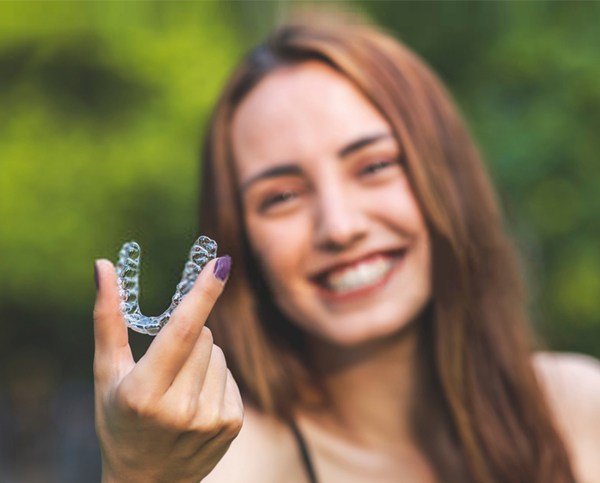
If any of your teeth are crooked, crowded, stick out or have gaps, the thought of wearing braces might have put you off orthodontics in the past. Made from clear plastic and virtually invisible on the teeth, Invisalign clear aligners can be an alternative to braces for people who are concerned about the impact of teeth straightening treatments on their appearance and lifestyle.
As the popularity of Invisalign has grown, so have misconceptions about what the treatment involves and what it can do. It's important that you know the pros and cons of any dental treatment before you agree to it, but you also need to be able to sort the truth from the myths.
Here are the facts behind some of the most persistent myths about Invisalign treatment and why they're wrong.
Myth 1: Invisalign is only for adults
Invisalign was originally designed to be a discreet and convenient option for adults who might not otherwise have considered orthodontics, but it's not restricted to over 18s. Older teenagers who missed out on orthodontic work in their early teens or who need more straightening done may also choose Invisalign over braces if they don't like the way braces look and feel.
Younger teenagers who are interested in Invisalign are specially catered for by Invisalign Teen. This is similar to the standard system, but the aligners also support the continuing development of the teeth and jaws. They also include wear indicators that show their dentist and other adults whether the patient been wearing their aligners as often as recommended. This helps to ensure compliance and better outcomes from orthodontic treatment.
Myth 2: Invisalign is less effective than braces
Invisalign can't treat all types of orthodontic problems, but for common alignment issues and crooked or crowded teeth, this treatment can be just as effective as traditional braces. More complex cases may also be treated effectively with Invisalign with regular visits to an experienced dentist.
As Invisalign aligners are removable, there's more patient compliance involved than with a fixed brace. The success of Invisalign treatment relies on patients wearing their aligners for the 20 to 22 hours recommended each day, only taking them out to eat, drink, brush and floss to maximise contact of the aligners with their teeth.
Myth 3: Invisalign can only fix mild orthodontic issues
Early Invisalign systems were more reliable when only minor straightening was needed, but with ongoing refinement of the technology, today Invisalign can treat most common misalignments and even more complex cases when the treatment is overseen by a qualified dentist.
Overbite, open bite, crowding and gaps are all common orthodontic problems that can usually be corrected with Invisalign treatment. If you have underbite, crossbite or other difficult alignment issues with your teeth and jaws, this varies from case to case. Your dentist will let you know whether Invisalign is an option or if you might get better results with braces or a referral to a specialist orthodontist.
Myth 4: Invisalign treatment is faster or slower than braces
Depending on what you read, Invisalign is often credited with working faster than braces or it can take longer to achieve the same results. This just shows how teeth straightening varies from case to case, with no fixed treatment time.
On average, it takes 12 to 18 months to straighten teeth using Invisalign. Braces have a slightly longer average up to 2 years, but that's including patients with more complex orthodontic needs whose treatments will take longer. Milder cases can sometimes be treated with Invisalign or braces in 6 months or even less.
Your estimated Invisalign treatment time will be based on you wearing your aligners for 22 hours a day as recommended. If you take out your aligners more often, they won't get to do their job and this could extend your treatment time. Oral health problems such as gum disease can also interfere with orthodontic treatment, so it's important to maintain good oral hygiene.
Myth 5: Invisalign requires more preparation of the teeth
Your dentist or orthodontist may sometimes recommend extracting one or more teeth or other preparation work such as sandpapering teeth if they think this will improve the success of your orthodontic treatment. However, this can be the case whether this treatment is with Invisalign aligners or traditional braces.
Since braces are more commonly used to treat more complex cases, it's more likely that you'll need to have a tooth extracted for braces than for Invisalign.
Myth 6: Invisalign is painful
No orthodontic treatment is entirely free from discomfort, as teeth straightening involves applying pressure to move the teeth into their new position. However, it's not true that Invisalign is especially painful. In fact, it's likely to cause less pain and discomfort compared to traditional braces.
Invisalign removable aligners are made from the manufacturer's patented SmartTrack® material, which is designed to feel soft, smooth and comfortable on the teeth. This avoids the irritation, scratches and cuts to lips and cheeks that sometimes happen with braces.
If your Invisalign treatment is painful or more uncomfortable than you expected, there might be something wrong. You should make an appointment to see your dentist for advice or to make adjustments to your aligners.
Myth 7: Invisalign affects your oral hygiene
Traditional orthodontics using braces or other fixed appliances makes cleaning your teeth and gums more difficult and time-consuming, as you have to work around the appliance and also clean the brackets and wires themselves. This increases the risk of problems such as tooth decay and gum disease, which can interrupt orthodontic treatment and affect its outcome.
Since Invisalign aligners are removable, and dentists recommend taking them out to clean your teeth, there's nothing to stop you from maintaining your normal oral hygiene routine. Your dentist may recommend brushing more frequently throughout the day to help prevent plaque from building up under the aligners, and you should also clean the aligners themselves.
Myth 8: You don't have to wear a retainer after Invisalign
Unfortunately, orthodontics with Invisalign doesn't eliminate the need to wear a retainer after your treatment to help maintain your new, straighter smile. Without a retainer holding your teeth in place, they're likely to shift back towards their previous alignment, undoing all your hard work and requiring a repeat treatment.
The good news is that Invisalign retainers can follow the same principles of discreet and convenient treatment as your aligners. Depending on how much straightening was done, you may be eligible for a clear retainer, a retainer you only need to wear at night, or a wire retainer hidden behind your teeth.
Myth 9: Invisalign costs more than braces
Invisalign treatment can seem expensive because of the initial cost of designing and producing your custom aligners, but the overall cost across the length of your treatment is comparable for Invisalign and braces. This also depends on how long you need to wear your aligners for and what type of Invisalign system you choose.
The average Invisalign cost at Sydney CBD Dental is from $5000 for Invisalign Light (used for minor teeth correction) to $7000 for Invisalign Full (for standard cases). In comparison, traditional braces cost $6000 to $7000 in most cases.
Whichever treatment you choose, orthodontics isn't usually covered by standard health insurance, but your insurer may help to cover the treatment cost if you have extra cover. At Sydney CBD Dental, we offer a choice of interest-free payment plans for Invisalign and other treatments if you'd find it easier to spread the cost across a number of months.
Myth 10: You don't need a dentist for Invisalign
If you've seen other clear aligners offered online and you're considering DIY orthodontics, you should be aware of the dangers. Teeth straightening is a complex treatment that should be planned and supervised by a qualified and experienced professional every step of the way.
When you choose Invisalign at Sydney CBD Dental, your experienced dentist will give you a complete orthodontic assessment and take 3D scans of your mouth. Using Invisalign software, we'll then design the ideal aligner sequence for you that will bring your teeth into the best alignment. Without this crucial planning stage, your home treatment may not have a clear direction and your teeth could end up even more crooked than before.
We'll also schedule regular check-ups at our George Street dental clinic every 6 to 8 weeks, depending on your orthodontic needs. This gives your dentist the chance to check that your treatment is on course and help you with any issues you're dealing with.
Book a free Invisalign consultation in Sydney CBD
Find out more about Invisalign at Sydney CBD Dental and whether it could be the right choice for you by arranging a free initial consultation with our dentists. We'll explain the pros and cons of Invisalign and make sure you have all the information you need to make an informed decision.
To book a consultation or ask any other questions, call our friendly team today on (02) 9232 3900 or book online.
